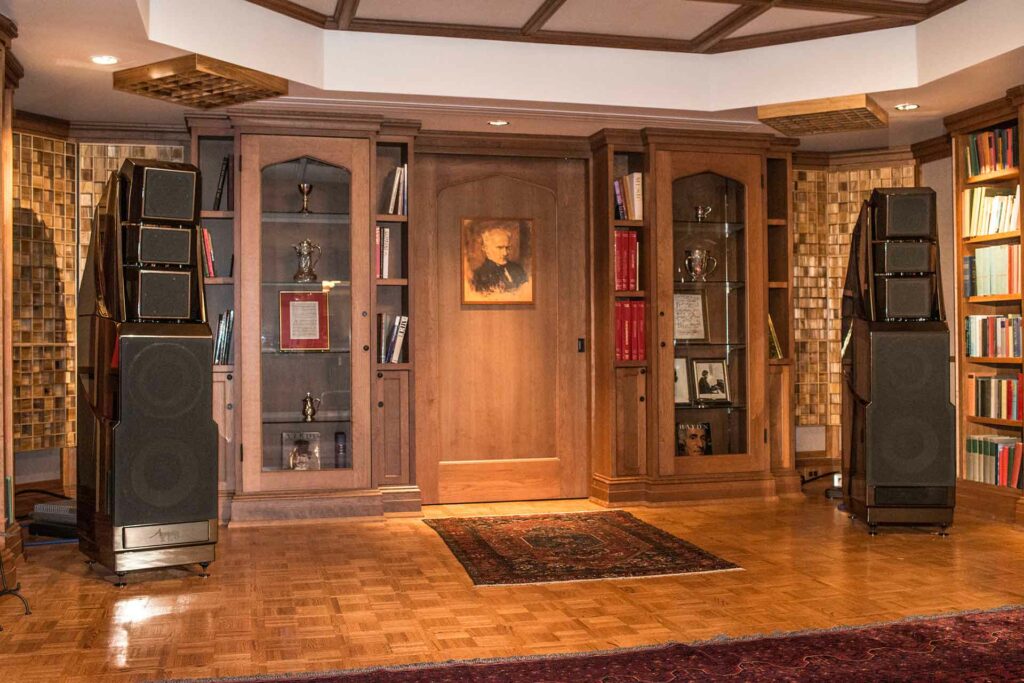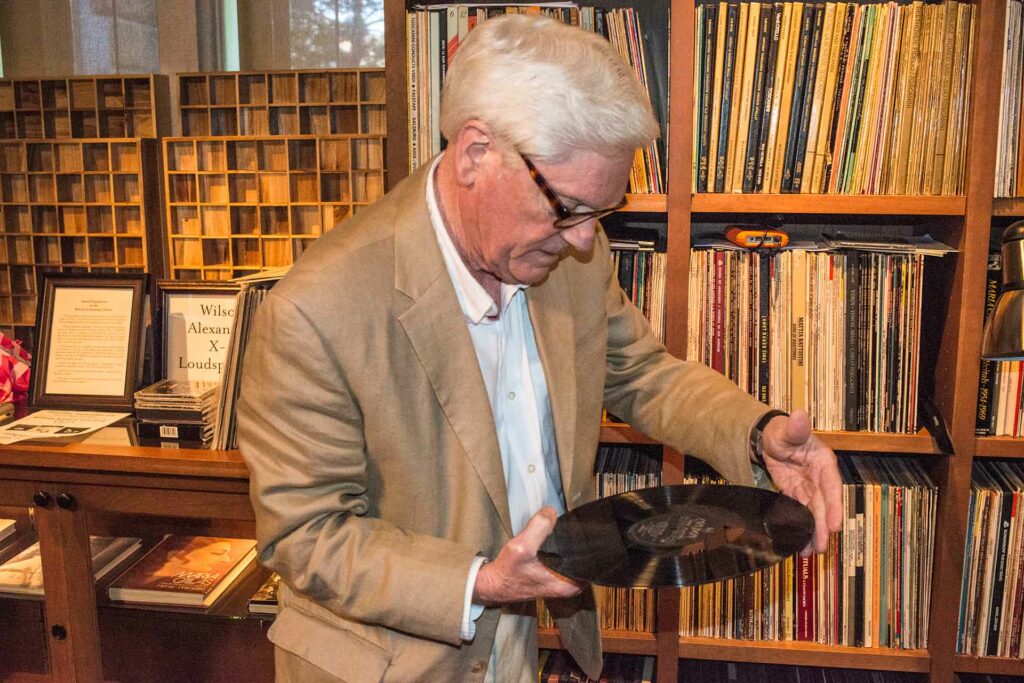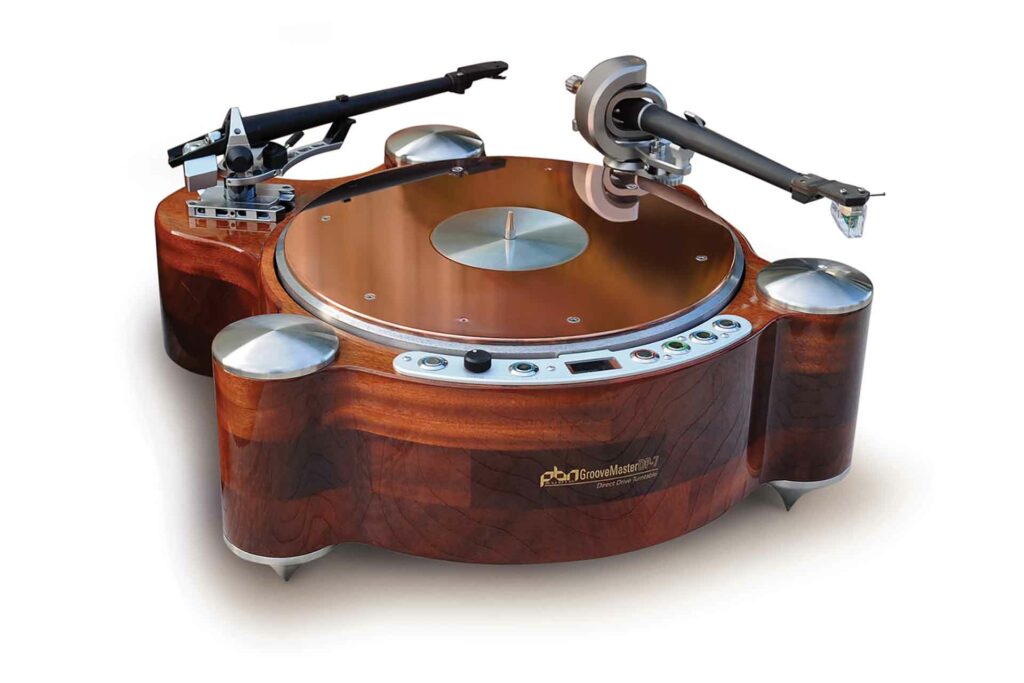The year was 2007, and Tam Carlson was a man on a mission. Tam wanted to build a cost-no-object listening room seating 20, in which every last detail would exist only to serve the playback of great music from an initial collection of 15,000 vinyl records.
But Tam was also a professor in one of the most fabled English departments in America, that of the University of the South, in Sewanee, Tennessee, whose Sewanee Review is the oldest continuously published literary quarterly in the United States.
Tam’s deeper goal, as he phrased it, was to save students from the solipsistic tyranny of listening to music on earbuds. He wanted to create a listening library that would promote music-listening as a shared activity and passion.
Tam strongly felt that way because group music-listening sessions were among the most important formative experiences he’d had when he was an undergraduate at Sewanee in the early 1960s. Carlson and his friends would gather in the living room of Charles Harrison, a beloved Professor of English, to listen to serious music on an impressive stereo system, as Tam explains in this video:
By the time all the dust had settled from the construction in the summer of 2010, more than a million dollars had been spent to transform a section of the second floor of Sewanee’s Jessie Ball duPont Library into a world-class audiophile listening room rivaling the playback in the most famous recording studios and mastering labs worldwide.
That transformation started with demolition, followed by the installation of isolated, balanced electrical service; a separate isolated and soundproofed HVAC system; and two-way acoustical isolation of the room to prevent loud music from leaking into quiet study areas. That groundwork was followed by acoustical treatment of the “muffin pan” poured-concrete ceiling; the installation of acoustical doors at both ends of the entry vestibule; the creation of an equipment room; the installation of lighting, shelving, and display cases; and the selection of furnishings.

How To Choose All of the Audiophile Equipment?
The original loudspeakers chosen for the room were Alexandria IIs, from Wilson Audio Specialties. The Alexandria IIs had an MSRP of $170,000 per pair. However, when Wilson Audio announced a larger, Extended Low Frequencies (XLF) version of the Alexandria, Sewanee traded up. At the time, the MSRP for the Alexandria XLFs was $200,000 per pair.
The Alexandria XLFs weigh 655 pounds each, while standing nearly six feet tall. 15- and 13-inch woofers in each speaker combine to push bass extension down to 19.5Hz (-3dB, in-room). That’s technically below the threshold of human bass perception.
Once the Alexandrias were set up and roughly positioned, we had what recording engineers call First Sound. From the first second of sound, the music was powerful, thrilling Chicago electric blues (selected by Wilson Audio’s Peter McGrath) that measured a clean, no-distortion 95dBA at the far end of the room, more than 25 feet away. The manufacturer claims that a pair of Alexandria XLFs can move the same amount of air as a live symphony orchestra.
The exacting tasks that came next were, first, fine-tuning the placement of the loudspeakers, listening critically to the all-important midrange while moving the loudspeakers in increments as small as half an inch. Then, the next challenge was to evaluate the sound throughout the room to assess the need for additional acoustical diffusion.
The two -by-two-foot wooden chessboard acoustical diffusion panels were carefully placed to scatter the sound that bounces off them widely. That ensures that the delicate high frequencies can be heard throughout the room with no dead spots. Diffusion also widens the listening sweet spot, where the three-dimensional illusion of stereo sound is strongest. The diffusion panels are behind and above the loudspeakers, on the ceiling around the lighting fixtures, and on the far rear ceiling, right before the vestibule.
In addition to the loudspeakers, other original components have also been upgraded. The Ralston Listening Room’s equipment list currently includes the following products by PBN Audio:
- GrooveMaster Vintage Direct DP7 turntable; based upon the Denon DP7000.
- PXi Phono Stage, with separate CPSi/p power supply.
- LXi Line-Level Preamplifier with separate CPSi power supply.
- EB-SA3 power amplifiers used as monoblocks.
Additionally, there is also a PS Audio DirectStream DAC and the PS Audio Memory Player. The room also makes use of a second turntable, an Ayre/Bauer DPS turntable and tonearm (valued at nearly $15,000) equipped with a Koetsu Coralstone phono cartridge (MSRP $14,995).
The PBN power amplifiers are capable of delivering 1,600 Watts into the 4-Ohm load of each Alexandria XLF; their MSRP is $31,625 each. The line-level preamplifier and the phono stage are $25,300 each.
The PBN GrooveMaster turntable is distinguished by its being designed for two tonearms, one for stereo and one for mono playback. In Sewanee’s case, the tonearms are by Kuzma and SME. The Kuzma tonearm carries a Lyra Etna stereo cartridge (MSRP $8,995); the SME carries a Miyajima monophonic cartridge. The GrooveMaster turntable itself is one of only three such that were ever made; its MSRP was $9,999. (Ask nicely, and PBN might be able to cobble one up for you.)
The PS Audio units are more modeestly priced, as the DAC is $5,999, and the Memory Player is $5,999.

Catching Up with Tam Carlson on Living with The Ralston Audiophile Listening Room
Seeing as the Ralston Listening Room has been a part of life at Sewanee for over a decade, I asked Tam Carlson to share a bit of a retrospective view with us.
Q. When you started this project, you must have had expectations; and also, a few hopes. Looking at the place the Ralston Room has today in life at Sewanee, as well as the amount of publicity it has generated, are you even a little bit surprised?
A. I’m not surprised in terms of its success at Sewanee. It’s even been a deciding factor for some prospective students. However, I have been surprised by the attention it continues to receive beyond Sewanee. It’s become a bit of a destination for people from around the country. We are also engaging the local community more now that we are able to offer live-streamed performances from the Metropolitan Opera throughout their season.
Q. If somebody happens to be traveling in the area, can they just drop by for a listen?
A. Absolutely. We encourage out-of-town visitors to contact us to make plans ahead of their visit by emailing the head curator at ralstonlistening@sewanee.edu. This is mostly because the listening room is used by classes throughout the year—whether by undergraduate music courses or masterclasses during the Sewanee Summer Music Festival—and we want to make sure our visitors get some time to experience the room on their own terms.
Q. Can you tell any stories about visitors or students who have had a transformative experience?
We’ve had people do everything from laugh to cry hearing music here. A visitor recently requested an album he said he’d listened to all of his life but had only heard when he listened to it in the room that day. That’s the sort of experience we hope people have here.
Again, we also have students every year who tell us this space was the deciding factor for them in choosing Sewanee over comparable schools. They frequently become volunteers, learning to correctly operate the equipment, hosting weekly sessions that they plan, and sharing their love for music with their peers in this space.
Q. If someone were to suggest that moving up from the Alexandria II loudspeakers to the Alexandria XLFs was overkill, what would your response be?
A. In this room, there is no overkill. In fact, we are contemplating upgrading to new loudspeakers. We are always working to improve the audio playback quality we can offer in the room and have been fortunate to have annual evaluations from both Peter Noerbaek of PBN and the conductor Col. Lowell Graham, both of whom have become devoted friends, advisors, and supporters of this project.

Q. Please list half-a-dozen recorded performances, for people looking for transformative listening experiences.
A. Richard Strauss, Four Last Songs:
Monophonic: Elisabeth Schwarzkopf, soloist, Ackermann/Philharmonia Orchestra; Angel (1954)
Stereo: Jessye Norman, soloist,
Masur/Gewandhausorchester Leipzig; Philips (1983)
Eric Whitacre, “When David Heard”
From: Water Night; Eric Whitacre, Eric Whitacre singers; Decca (2012)
Paul Robeson in Live Performance: Columbia Masterworks (1958)
Ad vesperas Sancti Ludovici Regis Franciæ: Marcel Pérès/Ensemble Organum, Ambroisie(2005)
Anton Bruckner, Symphonies 1–9: Wand/Kölner RSO, Deutsche-Harmonia Mundi (1974–1981)
Q. Is there anything I forgot to ask?
A. We’ve talked a lot of numbers, John, and a lot of people ask me how the project is funded. The reality is that we are almost completely self-funded by donations. Not only do we have the equipment and collection to maintain and improve over time, but we also employ a full-time curator and have routine, unpredictable expenses related to the operation and maintenance of our space. Of course, that means we always need support and are grateful to our benefactors for their faith in this unique project. If any of your readers want to support the Ralston Listening Library, they may make a tax-deductible gift by visiting ralston.sewanee.edu. They may also email us at ralstonlistening@sewanee.edu with further questions about the listening room or our collection.
Note: The author was a consultant to this project, both in equipment selection and in fine-tuning the room’s acoustics.




Vey nice write-up, John. I remember when you were consulting on this and the tireless hours you put into every detail.
One of the things that I am working on in my non-AV-life is trying to play the Golf Magazine Top 100 Courses (US) 2014-15 list. I am at 74/100 (and 19 of the Top 20).
Many of my missing courses are in the South East.
I want to tie in a trip to hear this system with some of the missing North Carolina courses!!!!
How many places are SO COOL to let people like us come by and listen?
I love being able to share this story – albeit one that others covered when the system was new. It is so good on so many levels.
Thanks for the story. I’d like to visit and it’s not too far away!
I want to go too!
So does Paul Wilson.
I love this concept.
When and what days may we schedule this wonderful experience?
Me and my Son are very excited!
This is just wonderful.
You gotta check with Tan because they do classes in there quite a bit but you can absolutely go.
Bring the a present (perhaps a non-classical LP?) or make them a small donation?
That is both completely bizarre and beyond cool at the same time. I’d love to know if it motivated any students to pursue the hobby we so enjoy. And, if so, how did it impact their purchasing decisions?
Inquiring minds want to know!